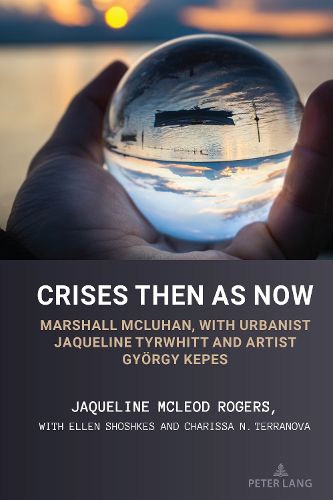Readings Newsletter
Become a Readings Member to make your shopping experience even easier.
Sign in or sign up for free!
You’re not far away from qualifying for FREE standard shipping within Australia
You’ve qualified for FREE standard shipping within Australia
The cart is loading…






This title is printed to order. This book may have been self-published. If so, we cannot guarantee the quality of the content. In the main most books will have gone through the editing process however some may not. We therefore suggest that you be aware of this before ordering this book. If in doubt check either the author or publisher’s details as we are unable to accept any returns unless they are faulty. Please contact us if you have any questions.
This book explores how Marshall McLuhan, with urbanist Jaqueline Tyrwhitt and artist Gyoergy Kepes, responded to crises in the 60s and 70s similar to what we now face: human-to-human violence on a planetary scale, carving inequities and fomented by arms and mediation; catastrophic human to non-human relations, with human activity sparking irreversible (and accelerating) environmental degradation; imbalanced human-to-machine relations, with computational decision-making outstripping human intervention.
McLuhan, Tyrwhitt, and Kepes called for redesign to stimulate sensory engagement and participation. Merging art and science knowledge was requisite to creating counter environments and livable futures and allowing humans to work with (rather than under or over) machines. Placed in dialogue, the three figures map out paths of hope as well as danger zones - geographies that speak to our present as we grapple with the role of technology in infrastructure and environment, art and culture.
"In this eminently timely book, McLeod Rogers and company recuperate the insights of McLuhan, Tyrwhitt and Kepes into the environmental and social crises of their day (which have only been exacerbated by the passage of time) and draw out the lessons of the trio's highly productive intellectual collaboration for designing an alternative, more balanced future imbued with hope, rather than anxiety and despair. This book is essential reading for scholars interested in urban planning, re-understanding media, and the fusion of art and science."
-David Howes, author of?The Sensory Studies Manifesto: Tracking the Sensorial Revolution in the Arts and Human Sciences
"Crises Then as Now expands our understanding of Marshall McLuhan by contextualizing his thinking in relation to two influential contemporaries and colleagues, Tyrwhitt and Kepes. Without sacrificing the distinctiveness of each protagonist, the reader is provided a venn diagram of the confluence of interest in the impact of technological developments on environments, ecologies, and humanity. This work draws a tread between theorist, planner, artist and, between then and now, to not merely identify the roots of the current planetary crisis, but to point to potential solutions." ?
-Susan Drucker, Lawrence Stessin Distinguished Professor of Journalism, Lawrence Herbert School of Communication, Hofstra University.
$9.00 standard shipping within Australia
FREE standard shipping within Australia for orders over $100.00
Express & International shipping calculated at checkout
This title is printed to order. This book may have been self-published. If so, we cannot guarantee the quality of the content. In the main most books will have gone through the editing process however some may not. We therefore suggest that you be aware of this before ordering this book. If in doubt check either the author or publisher’s details as we are unable to accept any returns unless they are faulty. Please contact us if you have any questions.
This book explores how Marshall McLuhan, with urbanist Jaqueline Tyrwhitt and artist Gyoergy Kepes, responded to crises in the 60s and 70s similar to what we now face: human-to-human violence on a planetary scale, carving inequities and fomented by arms and mediation; catastrophic human to non-human relations, with human activity sparking irreversible (and accelerating) environmental degradation; imbalanced human-to-machine relations, with computational decision-making outstripping human intervention.
McLuhan, Tyrwhitt, and Kepes called for redesign to stimulate sensory engagement and participation. Merging art and science knowledge was requisite to creating counter environments and livable futures and allowing humans to work with (rather than under or over) machines. Placed in dialogue, the three figures map out paths of hope as well as danger zones - geographies that speak to our present as we grapple with the role of technology in infrastructure and environment, art and culture.
"In this eminently timely book, McLeod Rogers and company recuperate the insights of McLuhan, Tyrwhitt and Kepes into the environmental and social crises of their day (which have only been exacerbated by the passage of time) and draw out the lessons of the trio's highly productive intellectual collaboration for designing an alternative, more balanced future imbued with hope, rather than anxiety and despair. This book is essential reading for scholars interested in urban planning, re-understanding media, and the fusion of art and science."
-David Howes, author of?The Sensory Studies Manifesto: Tracking the Sensorial Revolution in the Arts and Human Sciences
"Crises Then as Now expands our understanding of Marshall McLuhan by contextualizing his thinking in relation to two influential contemporaries and colleagues, Tyrwhitt and Kepes. Without sacrificing the distinctiveness of each protagonist, the reader is provided a venn diagram of the confluence of interest in the impact of technological developments on environments, ecologies, and humanity. This work draws a tread between theorist, planner, artist and, between then and now, to not merely identify the roots of the current planetary crisis, but to point to potential solutions." ?
-Susan Drucker, Lawrence Stessin Distinguished Professor of Journalism, Lawrence Herbert School of Communication, Hofstra University.